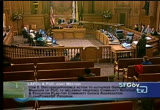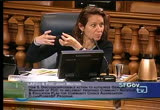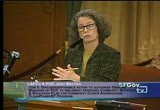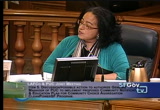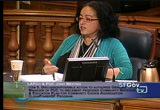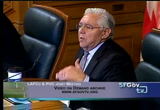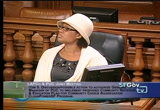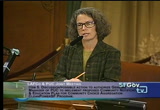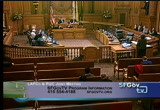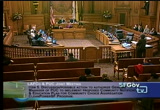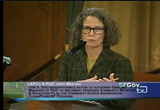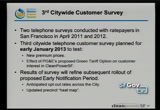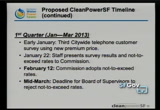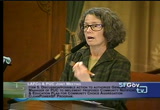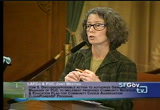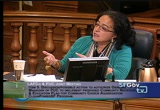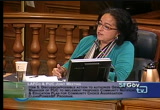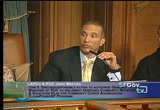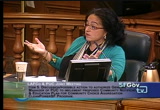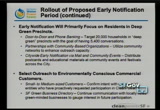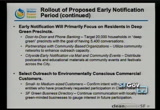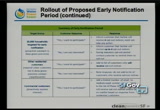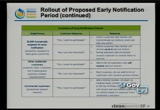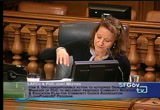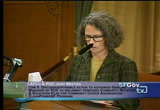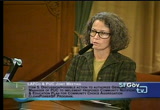tv [untitled] January 7, 2013 9:30am-10:00am PST
9:30 am
>> excuse me. i'm sorry. i have a follow up on that as well. is there a way -- i know we will talk at some point after -- it's separate, but the local build out conversation, and in the financing of that, and i'm actually at some point i think it would be have to have a lafco joint meeting that talks specifically about the financing of local build out and it's not on the agenda today, but perhaps one of the things that could be looked at is exactly what we're talking about here -- i don't know, fee structure, and if there is local generation that occurs that perhaps there is a conversation or some work that looks at those pg&e fees, and since it's really no longer going to be a pg&e provided service because it's generated by a local build out project perhaps there is a financial mechanism that could take place or enacted at that point. i don't know. i don't know if that has happened before or
9:31 am
some of the other nationwide programs that exist, but i imagine where that financial relationship begins to shift. >> it could be. the sfpuc has been active at the california public utilities commission ever whenever this issue comes up for evaluation so we're on the look out for opportunities to argue to have only justified and reasonable costs follow potential customers into the cca service provision, so it's not a charge that pays pg&e for kilowatt hours that are provided to the customer. there is no relationship between what the customer consumes in terms of the portfolio serving that customer and the cost responsibility surcharge. it's sort of an over hang cost pg&e is allowed to charge to make sure the customers that stay
9:32 am
for pg&e pay for cost it incurred on behalf of customers that left. >> commissioner olague. >> yeah, i guess -- it reminded me of pass throughs and tenants get charged sometimes for the increases and fees that the landlords have and i wonder how that worked ultimately but you kind of answered. >> okay. >> -- what i was thinking, but i guess i am concerned a little bit -- of course we want to definitely inform customers about these increases and rates that would result as part of this clean power shift, but i think -- i guess at some point i would be interested in understanding how that is going to be marketed or what language or what script would be used, because ultimately the goal isn't so much related to, you
9:33 am
know, -- well, i have to be careful how i say this i guess, but i guess the goal the city is reach 100% renewable electric supply within 10 years so we have these -- i think very lofty values in a good place so i want to make sure when we're approaching and informing customers about the incomes in rates that. >> >> increases in rates that it balances with some information about the value of trying to reach these goals that the city has put forward which have to do with makes sure that we get to 100% renewable electricity supply within 10 years, so i think how people are informed is pretty critical. >> yes, yes. and that's largely why we're making the presentation today is to talk
9:34 am
through what the different methods are. >> yes. >> we don't get to the level of detail of actual scripts but we do have examples of the questions we will be asking and the information we will be providing, and this bill premium chart is a good example of just the level of detail we can provide customer when is we talk with them because we will know what tier they're in and can say what your typical bill is like today and what it would like if you stay with the cleanpower sf program. >> it's deeper than the cost. some people see the value and investing in a sustainable future. >> right, and so talking about the product. >> and this is put on. look you will see the increases in your bills and then people might be inclined to opt out if they're not reminded of the value behind
9:35 am
the clean sf program. >> i understand and i take your guidance. thank you. >> we have -- go ahead. >> thank you. one of the issues reading through the material was the issue -- it's really an issue of auditing and that is who will determine the pass through cost that pg&e shifts to its shareholders versus to the rate payers? is that a function of the state agency or do we have independent jurisdiction over that process? >> we don't have independent jurisdiction. it's within the purview of the california public utilities commission. our role really is only as an active party there to try and influence their decision. >> so we wouldn't procure the services and audit and whether pg&e is following through on the commitment not to shift the rate for the rate payers and opting into our system?
9:36 am
>> i don't know that we would be barred from asking for audits, but it would be a discretion -- it would be at the discretion of the cupuc. they can audit but we don't have independent audit rights over -- >> [inaudible] >> we do for the franchise agreement. >> right. but we could recommend for the puc to take some action. >> i see the city attorney has advice for us. >> the proposed position is audits every two years with the code of conduct rules and rules of compliance. >> and that includes those factors that i raised? >> the code of conduct rules are the ones that would prohibit the utility rate payers for paying for marketing against a cca program. >> all right. i didn't see the specific language so if you could provide it to me that would be great. thank you.
9:37 am
thank you mr. chair. >> thank you. we have a couple of the people on the rooster who would like to speak. commissioner pimentel. >> do you know how the focus groups will be assembled and if they will have a diverse group of individuals throughout san francisco, and also in terms of the presentation do you have a break down of the presentation throughout san francisco in terms of districts? >> i'm sorry. i couldn't hear the last part. >> you want to speak right into the mic. >> in terms of the focus group how will you find the individuals for the focus group and will they have a diverse of individuals throughout san francisco and in terms of the presentation and distribution do you have a general idea of the break down throughout districts? >> so on the focus group formation we will rely heavily on our contractor to identify individuals, but we are looking for a diverse and
9:38 am
representative focus group. in terms of the break down -- no, our focus is on those areas of the city that as the chart shows are in the deep green sectors and so those are the areas we will be focusing on. we do have detail numbers behind the picture that we could certainly share with you, and have shared with the puc previously. >> okay. very good. commissioner mo ran. >> thank you through the chair do we know what the pg&e premium is likely to be for their green offering. >> in their initial proposal it was stated if memory serves me at not more than 2 cents -- 2.5 cents over what they currently
9:39 am
charge customers b again that is a proposal. it will go through the cupuc process and may change. >> when you say 2.5 cents is that literally -- like the $21.97 would go to $21.99? >> harlan kelly, general manager, so it's about $6 per month versus 11-dollar premium that we have equivalent to $6. >> yes, and that's for -- that's reflective for the cost difference between providing a renewable energy credit versus firmed and shaped renewable power, so it's the product difference that is embedded in that price difference which goes
9:40 am
to commissioner olague's statement that people need to understand the value behind what the price premium is addressing. >> and credit that pg&e can purchase rather than generate the clean power themselves . correct. >> correct. >> and we limit that component to 5% of the overall portfolio. >> thank you. commissioner moran any other? >> no. >> commissioner vietor. >> yes, i had a follow up with that. with the code of kukd and the script and how we talk about the cleanpower sf and the pg&e offering and i don't know if that is sort of -- you talked about that internally i imagine but i think that would be a very important part of the roll out plan and the outreach plan is
9:41 am
when that pg&e offering does come online how it will be talked about to the tar communities and the other groups that we will bring in down the road and i wanted to highlight that. i think that's important piece of the outreach program is how -- while staying within the bounds of the code of conduct -- >> right. >> how do we that and the 100% renewable and the 20% offering and really shows this is about a clean energy future. >> right and we will have the challenge of holding a potential customer's attention long enough to explain the differences as well and to educate on those nuances of renewable energy credit versus bundleeled kilowatt hours and it's complex and i don't know how long they will colerate
9:42 am
-- tolerate us on the porch talking but that is a key part and the education component in order to survey them and what they think is an important part of it, so we will be conducting our third city wide customer survey in early january to test this new premium price that we have established and as well as this and the pg&e green tariff option is available to them. we will use the results of the surveys then to redine the roll out of the program. it will help us make sure we anticipate the right number of -- right percentage of opt out across the city, and we will take that heat map i showed you with the green and that survey will modify the specifics of that heat map
9:43 am
again because we will have better information once again about customer acceptance of the program and then that wraps up the first quarter and we will have enough information then to come to the public utilities commission and ask the public utilities commission in about february to adopted -- not to exceed rates. it's our projected rate that is behind that bill premium i showed you, and that will begin the statutory rate setting process in the city that provides those rates that are adopted by the california public utilities commission to be placed before the board of supervisors for consideration, and so by mid-march we should have clarity what the not to exceed rate, what the affordability bar is for launching that cleanpower sf and that takes us through march.
9:44 am
>> has there been a lot of thought about actually trying to get closer to an actual rate rather than a not to exceed rate and outreach? what is the thought about creating the outreach plan? >> yeah, so the actual rate will be adopted probably in about the august time frame and the way -- well, the factors that play that are causing us to take this approach under our shell master agreement -- once that is signed then shell is able to present to us a portfolio of resources and a price that they are willing to commit to for the four and a half years. that's going to be the price that actually sets the actual rate. in order to have that firm commitment they need to make a quick turn around decision with us. they will survey the market. they will look at the resources at hand. they will make a price
9:45 am
commitment. we will need to say yes we will take it in a fairly short turnover time, like 48 hours, and so that allows us to know the -- the not to exceed rate allows us as staff to know what is considered affordable when shell comes with a final rate that we can factor into the rate model. is that going to result in a rate below not to exceed and if it is we as staff will come to the commission and may the general manager sign this confirmation with shell, and that's what a lock in the price that we will pay to shell and that we will be the basis for what we charge our customers for four and a half years. it's that approach that allows us to commit to a fixed rate for that four and a half year period. it escalates over time but we we will know what it is and
9:46 am
stability for customers at a rate they never experienced with pg&e before and that's an attractive aspect of it, but it requires the two step process on the rates and before we ask a customer if they want to opt out on the program we won't ask them with the not to exceed rate, but with the actual rate, so at that point when it's fish or cut bait time customer they will know what it is. >> they will know what it is? >> yeah. >> commissioner olague. >> yeah. it's along the lines of commissioner avalos asked. what is the time frame? when will we have those figures? it seems premature if we don't have those and seems like we're misleading the public. >> right. we don't do that until we have the rate.
9:47 am
>> the not to exceed really will allow. >> by january we will have those numbers. >> we're not surveying people in january. >> okay. >> we're still isn't notification and education phase at that point. we're not proposing to serve a customer until october under this program. >> okay. i guess i am wondering if we're surveying people do we have these actual rates and not to exceed rates in place -- otherwise we shouldn't be surveying people if we're misleading them. >> we don't serve anybody -- >> i mean surveying. >> oh surveying. excuse me. >> okay. >> i don't see the point to surveying people if we're creating some kind of maybe anxiety or fear around these rates that may not end up being the reality. >> so i just wanted to point out that the reason we're surveying
9:48 am
is to measure the appetite of what that price point is, and so what we're seeing -- >> okay. >> what number would be you be comfortable staying with this program? and we're seeing based on the numbers we're seeing now and if we get the same number now would you stay in the program for all these benefits that this program will offer? and it's consistent with what we have done better and hopefully we will get better results than before and then when we go through the process of actually getting the numbers if it's lower than what we are receiving now as far as rates then i think it's a good thing. >> so we've already had extensive outreach looking at price rates already -- >> but there were different price rates because we've had new input from everyone about making sure that we're able to pay back the security and what
9:49 am
the new premium, so the price is a little different and we want to make sure everyone is not miss lead so we want to reaffirm what the assumptions that we had before because we want to make sure the puc investment that we really kind of make sure that the roll out successfully. >> very good. commissioner olague any other -- >> yeah, i just wanted to make sure obviously if we're surveying people and we're presenting these numbers, and the actual is actually lower that we're not, you know, unintentionally creating a fear, anxiety among potential customers that isn't based in, you know, what is the ultimate figures or whatever. that's all. >> yeah. okay. thank you. so
9:50 am
by march then we will have this not to exceed rate that we have talked about, and we will move forward into the actual sort of retail part of our early notification program where we will be focusing on the residents that are in the deep green precincts and this is a refreshed informed deep green from the survey that we just took and we will talk to those folks. we anticipate working with community based organizations and programs like environment now to target 20,000 households. we expect that we will actually reach and have direct conversations with 5400 households and that means we're
9:51 am
looking at being 99% confident of the results of this survey with a not more than 2% margin for error or deviation from that. this will include distribution of postcards and other materials at community events and festivals across the city as well as this door to door "hi we're the cleanpower sf program and we want to talk about our offering". we're also going to -- in recognition of the fact some folks have called us and said "hey we're hearing about this program and we're interested". we're going to allow some commercial customers that seem to be expressing more than of an environmental consciousness based interest in our program to sort of cue up and be participants in this program,
9:52 am
so we our -- our prime area focus is residential but we will let commercial customer who is are interested be part of the program and make sure that we hear from them and right size the program commitment, that 20-30-megawatts and talk to some of those folks and if they will commit early, and to the extent there are -- there's more interest in the program from that sectorra than we expected we could have a wait list so as residential customers opt out we could say small commercial customer we will take you off the wait list and put you in the program. they will receive the same opt out notification treatment that residential customers in the deep green customers we're focusing on will receive so it's compliant with
9:53 am
the requirements of the state law. so what are we going to say when we're on your front porch? really what we're looking at here is educating folks and asking if they want participate. if they want to participate what are we going to do? we will tell them "great, you will receive opt out notifications and you don't need to take any action". if we're talk to a household that really is not interested. i'm having a hard enough time paying my bills. i really can't afford to make this choice, or i am just not interested. then we will be making sure that customer is aware of the opt out notifications they will receive. to the extent that we don't hear from them in reply of the opt out and we will go back and say "hey whrks we talked to you before you said you weren't
9:54 am
interested and you haven't sent the opt out in. did it get lost on the kitchen counter?" just to make sure that folks that told us they're not interested follow through and how to say no thank you through the opt out card and again we don't want accidental customers. it's not in our interest as their neighbors or from a business perspective either. there will be other residential customers who will be likely hearing about the cleanpower sf program and they might say even though we're not on their front porch and that is great and we will add them to the list of customers who will receive the opt out notice. there are those from the group they will say "i heard about this and i don't want it". okay we hear you. you're not part of
9:55 am
target group and there is a mention of it in the data base. >> we have a question. >> thank you. i'm in the same section you're talking about on the notification piece and i wanted to comment on the new emerging demographic that we all recognized from the last election that i think has huge potential to be participants and be excited about this program and young communities of color and different kinds of communities that before hadn't been as engaged, and it seems like a way to engage and educate those communities that really around social media, and i saw in here there is a big focus working with cbo's and operating their networks, but i would love to see something in here that social media is going to be
9:56 am
maximized, what that looks like, whatever the plan is and i know for me and i'm not the emerging demographic and i'm not home much but to reach that constituency we have to maximize the tools which they respond to. i would love to see that as part of the plan. >> all right. we will highlight that more. we have a website. you're certainly aware of the public utilities commission twitter and facebook and other social media activities and cleanpower sf will certainly be engaging in all of those activities. i think maybe it could be highlighted better in the budget section certainly where we're talking about how we're funding some of this media and outreach. it might be lumped a little too much under
9:57 am
online advertising and social media is a tool we love to use. it's one of the least expensive approaches and it's a great leveraging tool too. >> are we also looking at -- this is really like a field campaign. we've just come out of election season in san francisco. there are a lot of resources around doing field campaigns. are there folks hired as consultants or organizations that do a lot of outreach especially to communities of color that are involved in that outreach? >> yeah, that is all part of the community based organization and outreach we're looking at, and i absolutely want the folks that are representing our program to san francisco residents to be able to -- be reflective of the community they're talking to, so that's part of our focus, and
9:58 am
what we will be working with are communications consultants on making sure we achieve. >> who is the communications consultant again? >> the commission authorized us to contract on a limited basis with davis and associates. >> thank you. >> you're welcome. >> commissioner vietor do you have another -- >> no, i'm done. >> commissioner olague. >> yes, i guess that is concerning to me actually. >> okay. >> i just am not sure how much experience consulting groups have working directly with communities of color and low income communities and seniors and more disenfranchised groups so i think the social media works for a certain sector and even a certain generation and maybe a certain -- what's word? demographic within a certain range, right, but i think
9:59 am
sometimes lower income people have less i think there is still a digital divide that is very real in san francisco. one of the issues that we started taking up a little bit at planning was the issue of outreach and how does one really engage more effectively with those more disenfranchised communities or communities of color, people who language and age and this sort of thing, so i just think that's something that has to be really seriously looked at because i think we fail on a lot of levels, and one of the things we looked at when i was a member of the mission coalition we tried to popularize planning language so people who -- because sometimes what is so i guess challenging is that the language that explain some of
115 Views
IN COLLECTIONS
SFGTV: San Francisco Government Television Television Archive
Television Archive  Television Archive News Search Service
Television Archive News Search Service 
Uploaded by TV Archive on

 Live Music Archive
Live Music Archive Librivox Free Audio
Librivox Free Audio Metropolitan Museum
Metropolitan Museum Cleveland Museum of Art
Cleveland Museum of Art Internet Arcade
Internet Arcade Console Living Room
Console Living Room Books to Borrow
Books to Borrow Open Library
Open Library TV News
TV News Understanding 9/11
Understanding 9/11